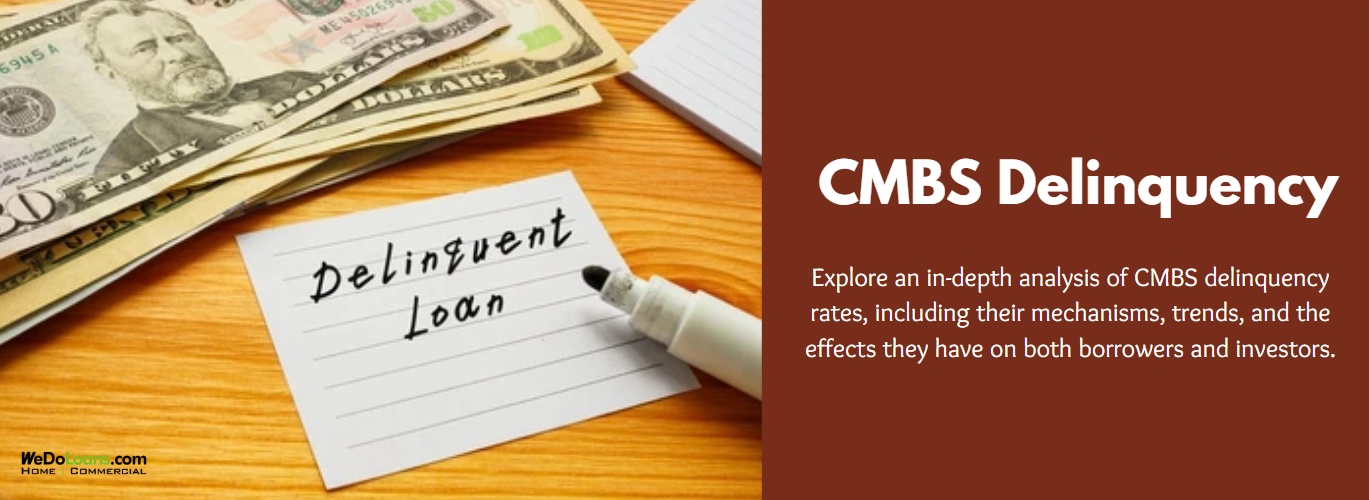
Commercial mortgage-backed securities (CMBS) delinquency rates have seen fluctuations in recent years, often spiking as the commercial real estate market adapts to changing work habits. Since CMBS loans are utilized by real estate investors and purchased by securities investors, these delinquency rates can have significant effects on both groups. This guide provides an overview of CMBS delinquency rates.
Understanding Delinquency Rates
Delinquency rates measure the percentage of loans that are overdue or in default. A loan becomes delinquent when the borrower fails to make payments on time, with common time frames for assessing delinquency being 30, 60, and 90 days. Even if individual real estate investors are current on their loans, the overall CMBS delinquency rate can still impact them, as lenders consider market-wide delinquency trends when setting terms and rates.
How Does CMBS Delinquency Work?
CMBS are financial instruments backed by a pool of commercial mortgages, which can include properties like office buildings, shopping centers, and hotels. The delinquency process for CMBS loans is similar to other types of real estate loans. If an investor fails to make payments, the lender will attempt to collect, and if unsuccessful, may move to foreclosure.
However, CMBS delinquencies differ because they affect not just the lender but also the investors who hold CMBS securities. When properties are foreclosed on and sold for less than the loan amount, investors may not recover their full investment. CMBS loans are packaged together to spread risk, but widespread increases in delinquency and default rates can still result in losses for investors.
What is the Delinquency Rate on CMBS?
The CMBS delinquency rate represents the percentage of the total balance of CMBS loans that are overdue. It’s calculated as follows:
Delinquency Rate = (Delinquent Balance / Total Outstanding Balance) x 100%
Trends in CMBS Delinquency Rates
CMBS delinquency rates are influenced by broader economic conditions:
- Boom Cycles: Economic booms generally lead to lower CMBS delinquency rates as commercial properties perform well.
- Recessions: Conversely, economic downturns can cause delinquency rates to rise as businesses struggle and rental income declines.
Historically, delinquency rates have hovered around 5% or lower but spiked to 13.9% during the 2008 financial crisis. Recently, the rate was 3.04% in December 2022, with projections suggesting it could reach 4.5% by the end of 2023.
Delinquency rates for office and industrial properties surged during the pandemic due to remote work and supply chain challenges but have since stabilized. Overall, delinquency rates have remained relatively steady since late 2021, peaking at 4.98% during the pandemic, significantly lower than during the Great Recession. The recent uptick marks the first notable increase since the pandemic, though even a rise to 4.5% remains well below the pandemic peak.
Understanding these trends is crucial, as they provide context and allow stakeholders to anticipate potential market shifts, facilitating proactive planning and decision-making.
Impact of CMBS Delinquency Rates
CMBS delinquency rates affect both borrowers and investors, though in different ways.
- Impact on Borrowers:
- Stricter Lending Standards: Higher delinquency rates may lead lenders to tighten underwriting criteria, making it harder for new borrowers to obtain loans.
- Increased Interest Rates: Lenders might raise interest rates to compensate for the heightened risk, resulting in more expensive loans for borrowers.
- Refinancing Challenges: Borrowers looking to refinance may face difficulties as lenders become more cautious or impose stricter terms in a high-delinquency environment.
- Impact on Investors:
- Disrupted Cash Flow: Delinquent loans can interrupt the flow of interest payments, reducing the overall return or yield on CMBS investments.
- Potential Losses: If properties are foreclosed and sold at a loss, investors risk not recovering their full principal amount.
- Market Perception: Rising delinquency rates can negatively influence market perception, decreasing demand for CMBS and potentially lowering prices in the secondary market.
Conclusion
Commercial mortgage-backed securities are a prevalent investment tool for both real estate and securities investors. Real estate investors use CMBS loans to finance property acquisitions, while securities investors seek returns from the interest on these loans. Both parties must have a solid understanding of CMBS loans, particularly the impact of delinquency rates.
